Goal: Unspecified.
Source: Unspecified.
An object’s motion is described by the graph:
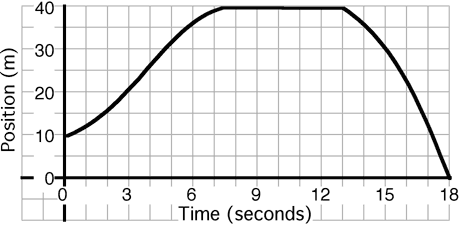
What is the instantaneous velocity at t = 3s?
- 0 m/s
- 2 m/s
- 3 m/s
- 4 m/s
- 5 m/s
- Other
Goal: Unspecified.
Source: Unspecified.
An object’s motion is described by the graph:

What is the instantaneous velocity at t = 3s?
Goal: Unspecified.
Source: Unspecified.
An object’s motion is described by the graph:
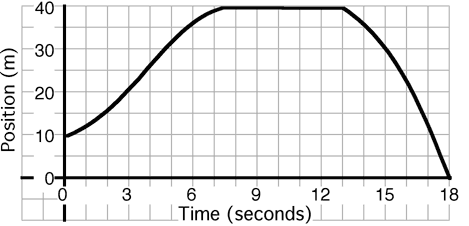
What is the instantaneous velocity at t = 10s?
None provided.
Goal: Interrelate representations of kinematical quantities
Source: CT151.2-10
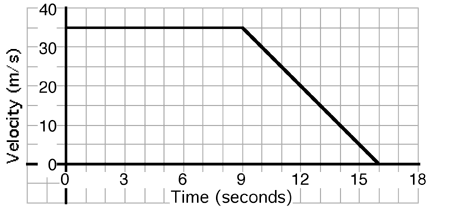
An object’s motion is described by the graph above. The displacement
of the object during the entire 16 seconds is most nearly…
(7) Students have difficulty reading graphs and finding areas.
Goal: Interrelate representations of kinematical quantities
Source: CT151.2-8
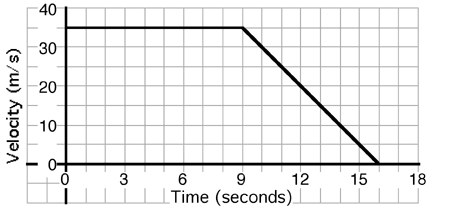
An object’s motion is described by the graph above. The position of the
object at t = 9 seconds is most nearly…
(6) This problem is primarily to determine if students appreciate the
information available from a graph. Many students will determine the
displacement forgetting that the initial position is unknown.
Goal: Reasoning with magnetic forces
Source: UMPERG-283-626
In the following situations a charge q moves in a uniform magnetic
field. The strength of the magnetic field is indicated by the density
of field lines. In all cases the speed of the charge is the same. For
which situation(s) will the charge q have the largest displacement in a
given time T.

(5) Since the speed cannot change, the greatest displacement will occur
when the path is a straight line. Some students may answer #10 thinking
that the time matters.
Goal: Reasoning with magnetic forces
Source: UMPERG-283-625
In the following situations a charge q moves in a uniform magnetic
field. The strength of the magnetic field is indicated by the density
of field lines. In all cases the speed of the charge is the same. For
which situation(s) will the charge q travel the greatest distance in a
given time T?
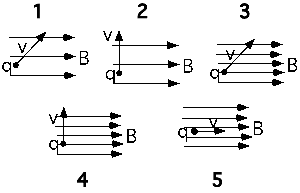
(9) The magnetic force can change the direction of the velocity but not
the speed. The distance traveled, therefore, cannot depend upon either
the strength or orientation of the magnetic field. It is important to
have students who pick one of the other choices verbalize their reasons.
Some students may interpret the question as asking for the
‘displacement’ and, thinking that the time is needed, respond #10.
Actually the result for displacement is #5.
Goal: Problem solving and developing strategic knowledge
Source: UMPERG-ctqpe104
You are given this problem:
A
block sits on a frictionless incline. Given the mass of the block, the
angle of incline, the distances d1 and d2, and
that the block starts from rest, find the time to travel from
d1 to d2.
What principle would you use to solve the problem MOST EFFICIENTLY?
(6) Students responding #1 are relying on memory and would have
difficulty if a force other than gravity was involved.
Goal: Hone the concept of displacement
Source: CT151.2-2
Bekki walks 3 m to the right, 4 m to the left, 5 m to the right, and 2 m
to the left. What is her displacement?
(3) Students need to distinguish between distance and
displacement. Questions such as this are good introductions to vectors.
Goal: Distinguish distance traveled from displacement
Source: CT151.2-1
Andy has the following series of displacements: 3 m to the right; 4 m to
the left; 5 m to the right; and 2 m to the left. What is his distance
traveled?
(8) Students just learning about vectors and displacements are
inclined to over specify quantities. Before they knew anything about
vectors they used distance as a scalar but can become confused and give
it the direction of the total displacement.
Goal: Reasoning with kinetic energy and work
Source: UMPERG-ctqpe58

Two
blocks, M2 > M1, having the same kinetic energy
move from a frictionless surface onto a surface having friction
coefficient μk.
Which goes further before stopping?
(1) For a given amount of kinetic energy M1 will have a larger
velocity. The penetration distance depends upon the square of the
velocity.
Many students will notice that the relationship equating the kinetic
energy to work by friction has mass as a factor on both sides and will
answer #3. They are assuming that the masses have the same velocity, not
the same kinetic energy.
Commentary:
None provided.